Did you insulate the facade, but made a mistake in the calculations? Or trimmed it with expensive materials? And in the winter they realized that saving on external insulation goes sideways. The boiler is working to the limit. Gas bills are daunting with the numbers in the "Total" column. It is better to insulate the house from the inside than to pay for heating the street. Don't know how to insulate the walls from the inside in a private house? Read, learn, use.
Insulation of the house from the inside is carried out if it is impossible to carry out or insufficient external insulation. It is necessary to dwell on the disadvantages of this method of saving heat indoors:
- insulation of external walls from internal heat increases the degree of their complete freezing in the cold season, which negatively affects their condition;
- "Dew point" (a place in building structures with zero temperature) is shifted to the inner part of the wall, which leads to an increase in humidity in the room, the risk of mold and mildew formation;
- there is a loss of 10% of the usable area of the interior.

Are there any advantages to this method of warming rooms? Undoubtedly. They are as follows:
- work is carried out at any time of the year, day and night, in any weather;
- there is no need to purchase (rent) equipment to ensure work at height;
- simpler and more inexpensive materials are used;
- the likelihood of carrying out work on the thermal insulation of the house with your own hands increases.
It is possible to avoid negative consequences in the form of wet walls, black mold spots, fungal spores on the inside, subject to the technology and the correct choice of a thermal insulator for a particular case.
Consumer requirements
Insulation from the inside requires a particularly reverent attitude towards the choice of insulation material. Placing it inside, in close proximity to a person, in a confined space, requires him to comply with safety standards.
What is the best way to insulate a house? It is necessary to determine what is an important and necessary condition for selection. Wall insulation inside the house must meet the following requirements:
- have a high degree of environmental friendliness;
- during operation, do not emit substances harmful to breathing into the environment;
- do not collapse for a long time;
- have a certain resistance to biological, chemical, mechanical stress;
- ensure the required level of fire safety.
What is used to insulate a private house from the inside? Fiber and polystyrene foam insulators.
Characteristics of heaters
Knowledge of the features and qualities of heat insulators will allow for effective internal wall insulation. The information obtained will help to understand how to insulate vertical surfaces made of this or that material, as well as to determine those works that will eliminate the negative qualities inherent to one degree or another inherent in each thermal insulator on a person.
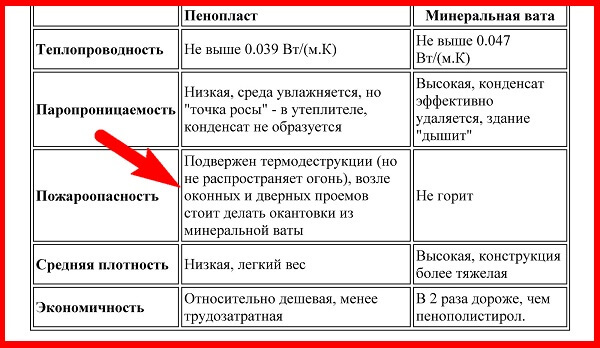
Mineral wool and organic insulation
Fiber insulation is the most common, well-known and studied material. The long service life made it possible to thoroughly study their positive and negative sides. They allow you to insulate the house from the inside with your own hands.

Produced from fibers of various origins, in their volume they have a large amount of air, which provides good thermal insulation properties.
The use in their production of natural stone and organic materials provide the necessary environmental safety.
Basalt heaters have zero fire hazard and biological activity (the spread of microorganisms, such spore fungi and mold), the rest are quite low due to the use of impregnation with fire retardants and stabilizers in their production.
The presence of a large number of voids inside the material ensures good air circulation in the thickness of the insulation, but increases the likelihood of moisture accumulation in case of insufficient vapor barrier of the layer, which can lead to a loss of heat retention capacity.
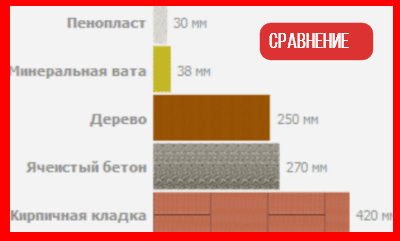
They have sufficient resistance to the vital activity of rodents, passive to active chemicals. They easily tolerate mechanical transformations; when the load is removed, they restore their volume.
Are not destroyed by sunlight. Requires protection from wind loads.
The production technology provides a service life of 50 years. Insulating the walls of the house with mineral wool from the inside is one of the most common insulation options.
Expanded polystyrene boards and liquid polyurethane foam
Despite some difference in shape, manufacturing and installation technology, these materials are combined into one group due to the extreme closeness of their chemical and physical properties and consumer qualities.
An extremely low coefficient of specific thermal conductivity is ensured by the presence in the mass of a huge number of closed volumes with gas.

This physical structure provides virtually zero water absorption and zero vapor permeability.
Produced on the basis of chemical components, they have a high degree of fire hazard. They light up when exposed to open fire, spread the flame over their surface, and emit poisonous combustion products. Not resistant to chemically active substances. They decompose when exposed to ultraviolet radiation.

While ensuring the required operating parameters, they are harmless to humans, do not emit harmful vapors into the air. Biologically passive:
- do not allow the development of microorganisms;
- not used for food by rodents and insects;
- not suitable for their residence.
They perfectly tolerate mechanical compression. Resists bending and kinking to a certain extent.
Compliance with technology is the key to success
Nothing is universal. This fully applies to heaters. Before insulating a house from the inside, it is necessary to find that combination of wall material, heat insulator, technology used, which will provide the maximum possible insulation of a private house from the inside.
House with breathing walls
Often, the insulation located inside the walls of wooden, frame, block houses is not enough to maintain a comfortable temperature in the premises. How to insulate a building made of porous or wooden materials? For such structures, the use of fiber insulation is recommended.

This is based on the fact that these wall materials absorb moisture from the ambient air when there is an excess of it and give it back when there is a shortage, carrying out self-regulation of humidity in the premises. Heat insulators based on fibers ensure the passage of the required amount of air through themselves, maintaining the natural state of the internal environment.
How to properly insulate such a private house from the inside? Do-it-yourself thermal insulation in a house with walls made of wood, gas, foam concrete, cinder blocks is carried out as follows.
A wooden crate is installed on top of the walls, which ensures the existence of a ventilation gap between the vertical surface and the insulation. The recommended clearance is 25 mm. On its basis, a lathing for laying the slabs will subsequently be installed. Therefore, it is necessary to install it at a distance of 30 mm less than the width of the insulation for installing the slabs.
A vapor barrier film is installed on top of it, which does not allow moisture to penetrate into the thermal insulator from the side of the wall. At the same time, it does not allow him to fill the ventilation gap. Fastened with a construction stapler in horizontal strips from bottom to top. The next layer is applied to the lower one with an overlap provided for in the manufacturer's instructions. The joints of the canvases are sealed with reinforced double-sided tape.
Ignoring this operation will break the tightness of the insulation belt, lead to the penetration of moisture into the insulation, getting it wet and reducing the heat-holding capacity by at least 50%.
On top of the vapor barrier, a bar is fixed for installing insulation slabs (mats). Its height should be equal to the thickness of the heat insulator layer. If the laying will be done in 2 layers, then the height of the timber should be equal to half of the used one.
An insulator is placed close to the vapor barrier membrane. When laying two-layer slabs of the 2nd level, they should overlap the joints of the first one.
They are installing a vapor barrier membrane. It will protect the created layer from moisture penetration from the side of the room. The technology of its fastening and installation is the same as that of the membrane from the side of the wall.
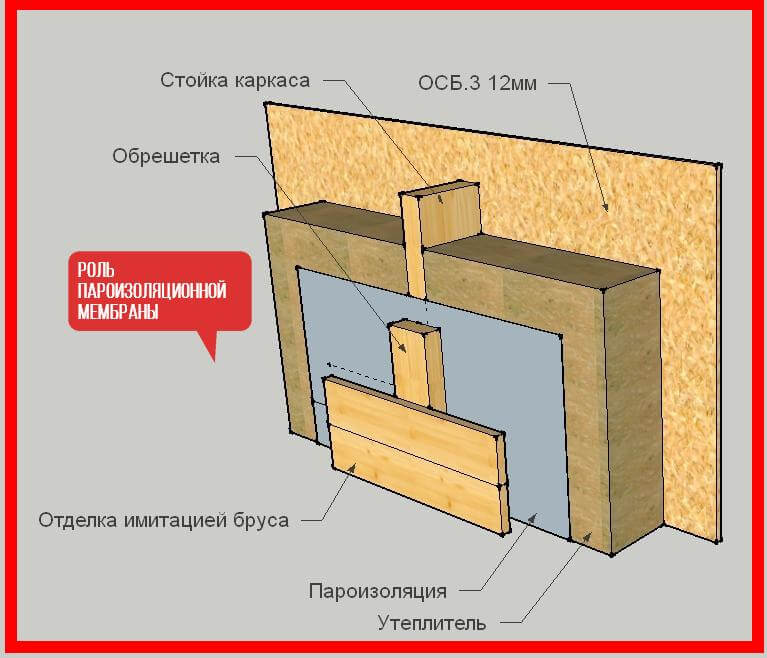
Internal insulation ends with the installation of counter-rails that create a passage for air between the insulation and the interior finishing.
When laying the insulation under the lining, placed vertically, the counter battens must be installed horizontally.
Installation of the base for interior decoration is being carried out.
House with walls made of stone materials
Such materials reasonably include brick, concrete, natural stone. How and how is such a building insulated?
Before insulating the walls of the house from the inside, you need to take care of the good operation of the ventilation system, since in such rooms the absorption of moisture from the air in the rooms occurs only at the level of decorative finishing.
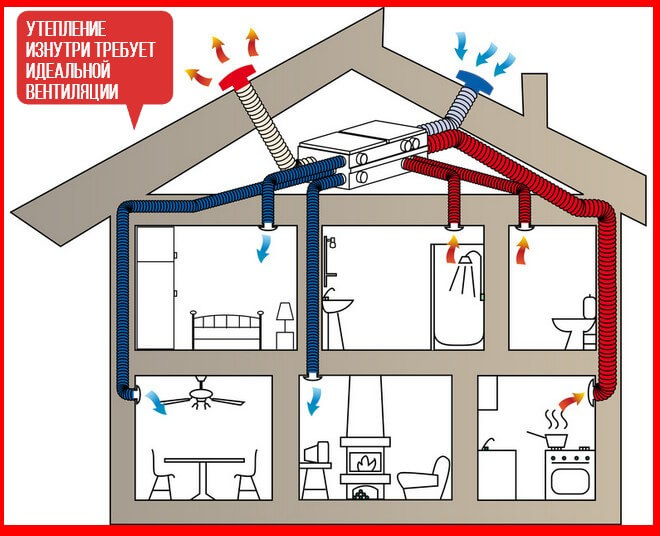
In addition to the standard ventilation ducts installed and provided for in the construction of it, it is possible to use chimneys of heating furnaces, boilers of heating systems, internal fireplaces, valves on windows with double-glazed windows.
Since the walls do not absorb water vapor and, therefore, do not give it away, the insulation has zero vapor permeability, the use of vapor barrier membranes is impractical.
To insulate the walls inside a stone house, it is necessary to use heat insulators with similar properties. These are expanded polystyrene and polyurethane foam.
Expanded polystyrene can be foamed and extruded. The former have a much lower mechanical strength than the former, and a higher coefficient of thermal conductivity (by about 15%).
If the question arises: "Is it possible to insulate the house with foam?" We answer: “Yes, you can. Styrofoam is expanded polystyrene foam ”.
In order to insulate the walls from the inside of the house, you need to start by preparing the surface. The masonry is cleaned of dirt, dust, paint, protrusions. If there are depressions more than 5 mm, they are filled with a cement-sand mortar.
Cracks are expanded and filled with mortar or polyurethane foam. The entire surface is covered with a deep penetration primer twice.
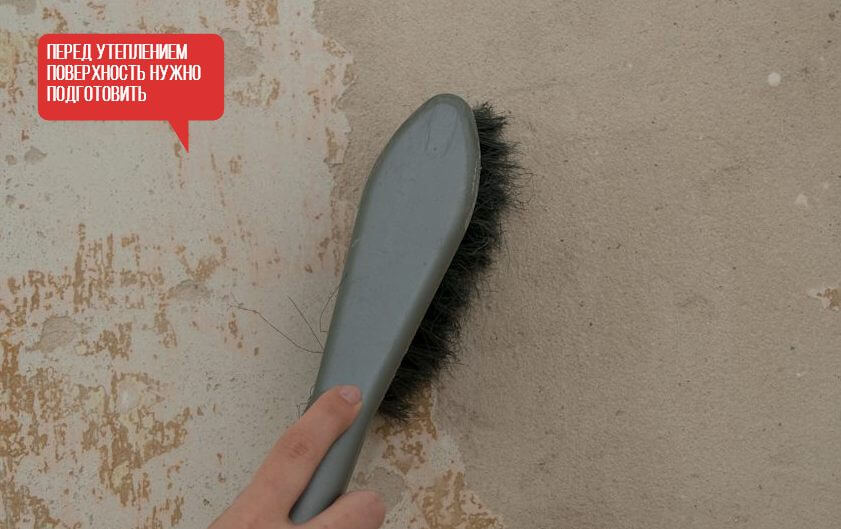
For gluing the boards, a special glue mixture or polyurethane foam glue in cylinders is used. The glue is prepared immediately before use by mixing with water according to the instructions for use. Mixed with a construction mixer and delivered to the work site.
The adhesive is applied to the board in two ways:
- with a trowel - along the perimeter and several "slaps" in the middle for uneven walls (height difference of about 1 cm);
- with a notched trowel - over the entire area with even walls.
- The application of polyurethane foam adhesive to the board is done with a foam gun around the perimeter and center along the length of the side.
Is it possible to insulate a house from the inside by applying polyurethane foam? How then to install the finish on an uneven surface? Before insulating a private house by spraying polyurethane foam, install a wooden lathing from a bar, a height greater than the thickness of the insulation layer, on the wall.
Plates are stacked from bottom to top along a previously broken horizontal line. The next row is installed with an offset of half a slab (like brickwork).
Any excess glue that comes out is removed immediately. Seal the cracks between the polystyrene plates with polyurethane foam. Extruded polystyrene foam has special grooves at the ends of the plates to ensure their tight fit to each other without the formation of cold bridges.
Thermal insulation from the inside can be arranged in one or two layers. With two-layer insulation, the slabs of the 2nd layer must overlap the seams of the 1st.
On top of the insulation, a frame is installed for the installation of finishing from sheet, panel or lamellar materials and its construction is carried out.
Insulation of the walls from the inside will give a good effect if the installation technology is observed, which will significantly increase the comfort of living if it is impossible to carry out insulation from the outside.



